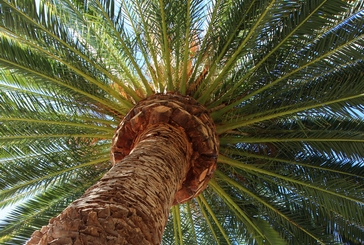Introduction
There are over 2,500 different palm tree species in the world. Palm trees can be separated into few major types depending on their trunk, leaf structure, growth rate, size, and cold tolerance. Aside from this basic segregation, palms also differ in salt and drought tolerance, leaf color, fruit and flower production. While most grow in tropical and subtropical climates, others can tolerate cold temperatures down to -20F.
Common Varieties
Common varieties include Royal Palm, Sabal Palm, Canary Island Date Palm..The list goes on with over 2,000 species. Others include:
- Bismarck Palm
- Cabbage Palm
- Carpentaria Palm
- Chinese Fan Palm
- Christmas Palm
- Fishtail Palm
- Key Thatch Palm
- Macarthur Palm
- Pindo Palm
- Paurotis Palm
- Pygmy Date Palm
- Queen Palm
- Senegal Date Palm
- Sentry Palm
- Washington Palm
- Windmill Palm
- Yellow Butterfly Palm
General Information
With Palms it is important to take special care for their roots. Unlike a typical tree, a Palm does not have roots growing deep beneath the tree. Root balls branch very little and do not increase in size with the growth of the above ground tree.
Most palms have a single trunk (coconuts), though some species grow as clustering or clumping palms (fishtails)
A Palm has a single growing point at the top of its trunk. This point and its surrounding tissues are called the terminal bud. If the terminal bud is injured, the palm may die. The roots of a palm do not thicken like those of other trees so palms are less likely to damage sidewalks and utilities.
Most palms are container grown at nurseries, though some may be field specimens. Either way, choosing a healthy palm at the get-go will help for health down the road.
Soil
An important factor for the health of a palm tree is its soil. Compacted, nutrient-deficient soils found in most urban environments do not contain the components necessary for a palm to truly thrive. Palms receive a bulk of their nutrients from the top soil and the top of the nearby ground meaning proper fertilization is required.
Watering
For new palms, you will need to water at least twice a week for the first 6 months. Add enough water to ensure moisture is penetrating a foot and a half of the soil. If you soil is sandy, make sure to add extra water as sandy water doesn’t maintain moisture.
For established palms, watering will depend on the climate, season and rainfall frequency. In many areas, twice a month during the summer decreasing to once every six weeks during the colder season should be enough.
Fertilization
According the University of Florida’s agricultural research division, IFAS, 8-2-12 is the ideal mix for Palm trees and ornamentals alike. Palm nutritional requirements vary considerably from other plants, particularly turf. You may find the exact IFAS mix in PalmGain 8-2-12, available at Home Depot and our online store.
[wwcAmzAffProducts asin=”B00CO8I8NM”][/wwcAmzAffProducts]
Pruning
Most trees shed their fronds naturally. Only yellowing/browning/old fronds should be removed as removing young fronds takes needed nutrients away from the tree. Remember to never trim too close to the trunk of your Palm. The bark is easily damaged and the resulting wounds are entry points for insects and disease.
Lastly, never prune or off more of the Palm’s leaves in one year than are produced during that time. Research done by E. J. H. Corner (1966) indicates that each species of Palm has a set number of green live fronds with the same number of developing fronds inside the bud area of the Palm Trees. As a new frond emerges, the oldest frond dies. The age that a frond may attain will be determined by many factors including size of mature Palm Trees, number of fronds produced, etc.
Pest and Diseases
Palms are susceptible to infections by viruses, bacteria, and fungi, as well as to infestation by insects and other pests. Infectious agents and pests vary widely by region and county. The most common are listed below,
Pests
Cabbage Palm Caterpillar
Cabbage palm caterpillars, found throughout Florida, target the cabbage palmetto almost exclusively. They rarely kill palm trees but the insects do destroy the trees’ blossoms. They are a nuisance to humans as well because they often enter homes looking for suitable places to pupate. Control by insecticides is possible under certain circumstance if carefully managed.
Giant Palm Borer
The borer is a large and quite ugly beetle whose larvae have a taste for the wood of the Washingtonia and Phoenix varieties. Borer grubs can live inside a palm trunk for up to nine years before exiting as beetles through quarter-sized holes.
Palm Budworm
The budworm is beetle whose larvae feed on the flowers of a range of fan palms. The caterpillars are about an inch long and a pink-green in color.
Palmetto Weevil
The Palmetto Weevil can be found throughout Florida, as far west as southern Texas and as far north as South Carolina. It is North America’s largest weevil. This pest has a taste primarily for the Cabbage Palm (sabal palmetto) although it will infest Saw Palmettos (serrenoa repens) and, occasionally, Canary Island Date Palms (phoenix canariensis), Washington Palms (washingtonia), Royal Palms (roystonea), and some coconut palms.
Royal Palm Bug
Royal Palm Bug feeds on only one plant, the royal palm, and the female lays one egg a day during the spring. The bugs rarely kill the host tree but the damage they do can be unsightly and they are difficult to control given the height of mature royal palms. These insects are the only North American members of the Thaumastocoridae family.
Thrips
North America’s thrips make up an extremely large family of insects. Of the plant feeders alone, there are 264 species. And some of these species have a taste for palm trees, feeding on flowers and leaves by puncturing the surfaces to suck out sap. Thrips are not lethal to palms but the feeding of the adults can discolor and wilt leaves. In addition, in intensive infestations their unsightly black droppings can become noticeable on leaf surfaces.
Diseases
Bud Rot
Bud rot is caused by a fungus which causes the heart fronds of a palm tree to wilt and die. Tree death can occur soon afterward. California and Mexican palms are the most vulnerable.
Fusarium Wilt
Fusarium wilt is another palm tree fungus. Signs of wilt are fronds wilting, losing their green luster and, finally, dying. Once a tree is infected, there is no cure and the diseased tree may have to be removed.
Ganoderma Butt Rot
Ganoderma butt rot is a relatively new and lethal disease of Florida palm trees. It is caused by a fungus, Ganoderma zonatum, which invades the base or butt of palm trees up to a height of three to four feet above the ground. The disease was first discovered in Florida in 1994 and in only a few years it has spread to infect palms throughout the state. At this time, it cannot be said with certainty that there are any palm trees resistant to ganoderma butt rot.
Lethal Yellowing
Lethal yellowing is a disease first noticed in the Caribbean region of North America about 100 years ago. However, it was not until the 1950s and a devastating outbreak in Jamaica and the Florida Keys that the economic consequences of lethal yellowing were recognized and intensive research begun.
Weather
Cold weather can affect plants in a variety of ways. First, frost or freezing temperatures can damage the actual tissue of the plant as well as limiting the conduction of water through the trunk. As well, cold weather will slow down the growth of your palm and reduce the activity of the roots. As this occurs, the palm is weakened and susceptible to the perils of disease.
Blankets wrapped around the trunk and top of the soil is an easy way for homeowners to protect their palm from a cold snap. Be sure to remove the blankets after a few days, when the weather has warmed up.
[/groups_member]


